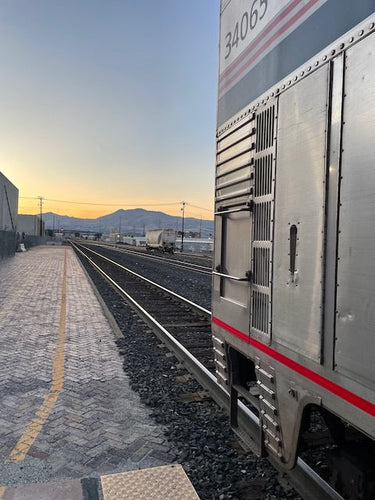
Embracing the Journey: Experiential Travel with My Autistic Teen on a 30-Day Amtrak Adventure
Share
Amtrak Rail Passes are on sale now- are you ready for adventure? As a parent of an autistic teenager, I’ve learned that some of the most meaningful growth happens outside the classroom. We use travel as a way to get out into the community and try new things. Flexibility is sometimes easier for my teen when were are not in familiar territory. For the summer of 2023, my son and I embarked on a transformative journey—a 30-day Amtrak train pass adventure that took us from Dallas to some of the most iconic cities and landscapes across the United States. This experience wasn’t just about sightseeing; it was about exploring the world in a way that engaged my son’s curiosity, sensory preferences, and love of structure while creating memories we’ll cherish forever.

The Journey Begins: Why Train Travel?
Trains became our ideal travel choice for several reasons. The rhythmic movement, spacious seating, and predictability of timetables provided a sensory-friendly environment that eased the challenges of travel. Plus, the opportunity to watch the changing landscapes through the wide windows turned every ride into a moving masterpiece. We were able to snap up Amtrak's 30 Day Rail Pass on sale for just $299 each which covered all of our train tickets criss-crossing the country.
Starting in Dallas, our Amtrak pass became our ticket to adventure. Over the next month, we journeyed to Chicago, Boston, Washington, D.C., Philadelphia, San Francisco, Seattle, and Glacier National Park. Each destination offered new experiences, a blend of history, nature, and discovery that resonated with my son’s love of learning.
Learning On the Go: Museums, Monuments, and More
Thanks to the ASTC (Association of Science-Technology Centers) Passport Program, our home museum membership unlocked free admission to incredible museums in nearly every city. From the awe-inspiring Field Museum in Chicago to the engaging Museum of Science in Boston, these visits provided hands-on learning that catered to my son’s visual and experiential learning style. The ability to explore exhibits at our own pace allowed us to bypass potential sensory overload and focus on what truly sparked his interest.
In Washington, D.C., we walked through history at the Smithsonian Museums and explored the monuments on the National Mall. Philadelphia offered a deep dive into America’s founding, and Boston charmed us with its blend of history and innovation. We navigated these cities primarily on foot and via mass transit, which became its own adventure. My son loved figuring out subway maps and train schedules—a real-world lesson in problem-solving and spatial thinking.
Nature’s Classroom: Glacier National Park and Beyond
Our trip wasn’t all about bustling cities. Glacier National Park was a breathtaking pause in our urban itinerary. The towering peaks, serene lakes, and quiet hiking trails provided a sensory reprieve and a chance to connect with nature. We got off the trail in East Glacier where there was a cozy hostel we could get to on food hired a local Blackfeet tribe member as a guide to take us on the hike to Grinnell Glacier. On the way she pointed out medicinal herbs, edible plants, and imbued our hike with fables and stories from her tribe on the Blackfeet names and history of the area. We learned so much and she was so patient and accommodating for our flatlander capacity at the higher altitude.

In San Francisco and Seattle, we explored iconic parks like Golden Gate Park and Discovery Park, balancing structured activities with unstructured time to recharge. Walking through nature proved to be as educational as visiting a museum, teaching us both about ecosystems, conservation, and mindfulness.

Budget-Friendly Travel: Private Hostel Rooms and Simple Comforts
Traveling on a budget meant getting creative. We saved money by staying in private rooms at hostels, which provided a balance of affordability and privacy. The hostels offered communal spaces for making meals and meeting other travelers, and the private rooms ensured my son had a quiet retreat when he needed to decompress. Many had game rooms, laundry centers, discounts to local sights, and meet-up groups in the evening for neighborhood walks or tours. They were all centrally located and within walking distance of the train station or a subway stop.

Amtrak’s onboard café car provided snacks and drinks along with an ever-changing view. We brought our own food and a mini-kettle to heat it to save money and filled downtime with card games, books, and mini-Lego builds of monuments we had visited, collected from gift shops along the way.

The Transformative Power of Experiential Travel
This 30-day journey was more than a summer vacation; it was a learning experience that built my son’s confidence, independence, and resilience. He learned to navigate new environments, adapt to changes, and embrace the joy of discovery. Watching him thrive in situations that might have seemed overwhelming before filled me with pride and gratitude.
For parents of autistic teens, experiential travel offers an opportunity to teach real-world skills, foster adaptability, and create shared memories. Whether it’s the structured schedule of a train ride, the hands-on learning of a museum visit, or the simple joy of hiking a mountain trail, these experiences provide lessons that extend far beyond the trip itself.
Tips for Planning Your Own Adventure
- Start with Interests: Tailor your itinerary to activities that align with your child’s interests. Museums, parks, or specific landmarks can serve as anchors for each destination. We had whole days in certain cities dedicated to visiting places that appeared in the Percy Jackson book series, a favorite of my son.
- Leverage Memberships: Take advantage of programs like the ASTC Passport Program for free or discounted museum admission. Call your local art and science museum to see if they participate in the program.
- Plan for Sensory Needs: Incorporate downtime, bring favorite sensory tools, and choose accommodations that offer privacy. Transitions are difficult, even with teens. If they know that the schedule includes some time to space out or play video games, the day's activities will be less stressful.
- Choose Flexible Transportation: Train travel provides a more relaxed and spacious alternative to flying or driving. We didn't rent a car so it did limit what we could see in certain cities but it also provided opportunities to learn about bus schedules and subway tickets.
- Pack Light: A simple packing list makes navigating multiple stops easier and less stressful. The hostels were set up for longer term traveling and we were able to wash clothes and restock our food and snacks in each city instead of bringing a month's worth of supplies with us at the onset.
Looking Ahead
As we look back on our summer of trains, cities, and landscapes, I’m reminded of the incredible resilience and adaptability my son displayed. This journey strengthened our bond, broadened his world, and proved that experiential travel is one of the most rewarding forms of learning—for both of us.
If you’ve ever thought about embarking on an adventure like this with your neurodiverse child, I can’t recommend it enough. Start small, plan thoughtfully, and watch as the world opens up in ways you never imagined. Because sometimes, the best classrooms aren’t classrooms at all—they’re the ones you discover together, one train ride at a time.

